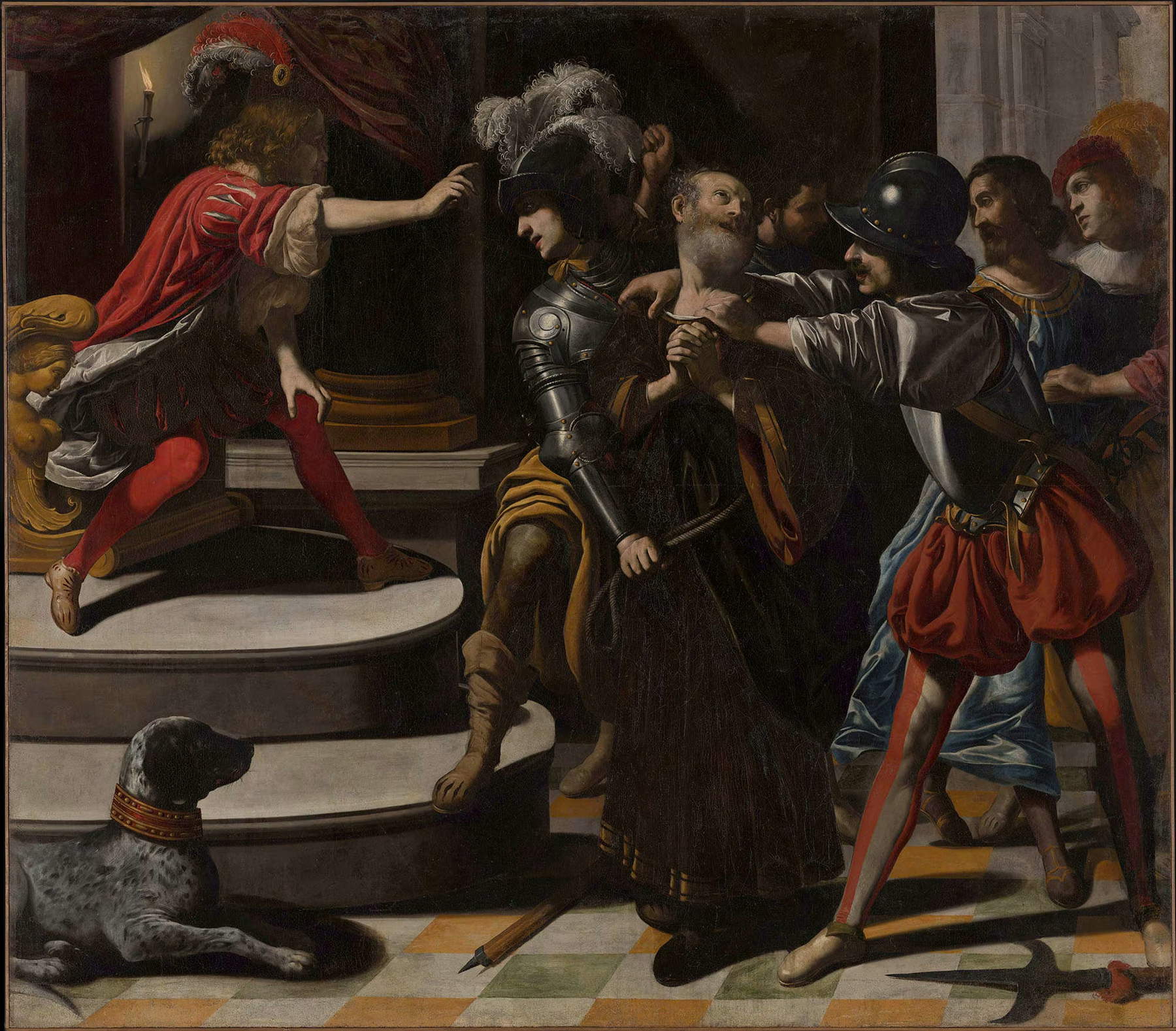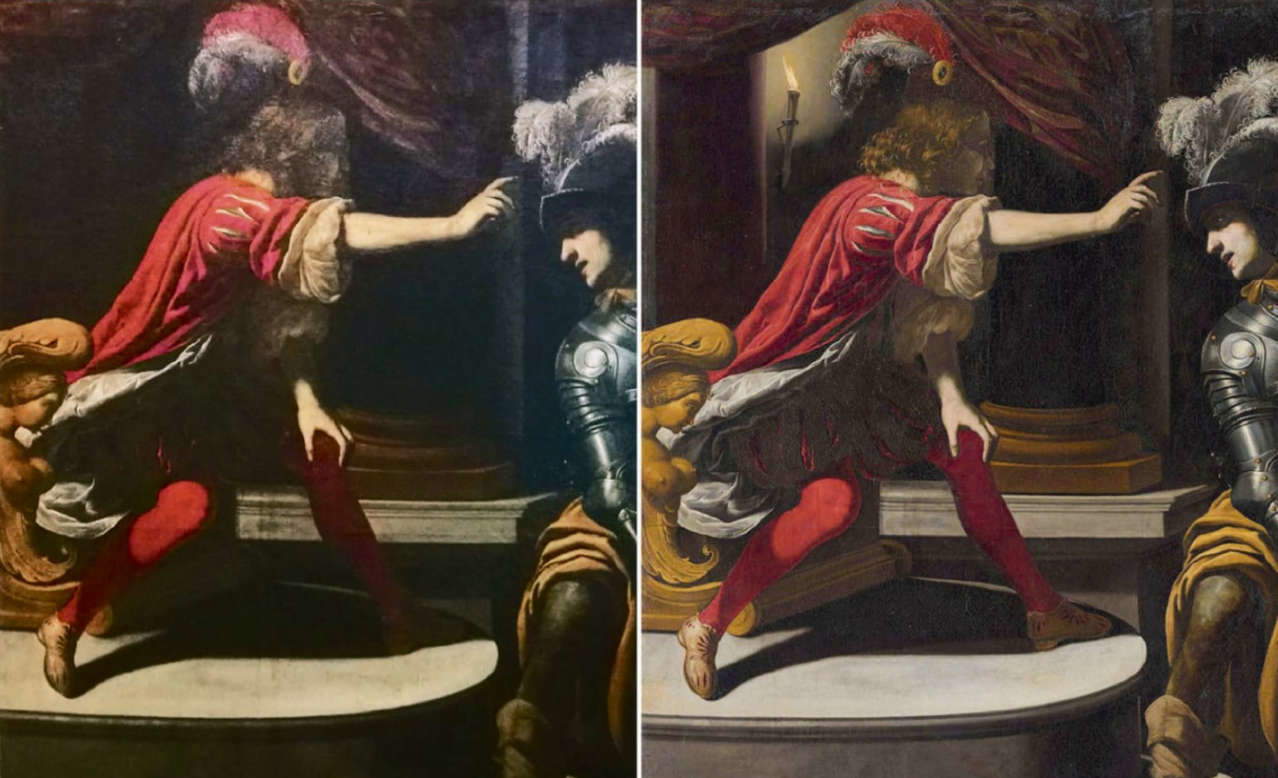More trouble for undersecretary Vittorio Sgarbi: after Fatto Quotidiano ’s hammering campaign about his activities, now the newspaper, with an investigation conducted together with Report, is back on the art historian regarding a painting by Rutilio Manetti (Siena, 1571 - 1639) that was stolen in 2013 from the castle of Buriasco in Piedmont, near Pinerolo, and that would bear disturbing similarities to a painting owned by the Cavallini Sgarbi Foundation, which was presented as unpublished two years ago at the exhibition on Pietro Paolini and the Caravaggio painters that Sgarbi curated at the Cavallerizza in Lucca.
“The painting,” read the catalog entry signed by Sgarbi and Marco Ciampolini, an art historian and expert on seventeenth-century Sienese painting, "is unpublished. It stood in the Villa Maidalchina, of Olimpia Pamphilij, née Maidalchini, near La Quiete, in the La Pila district, near Viterbo, now the property of the Cavallini Sgarbi Foundation, erected between 1615 and 1623. The painting is mentioned, generically among other paintings, in the October 11, 1649 inventory, drawn up by notary Cosimo Pennacchi, of the property of Andrea Maidalchini, Olimpia’s brother. The artworks, including the famous Bust of Innocent X by Alessandro Algardi, later passed to Giulio Bussi and the Gentili counts. The singular square format is due to the curtailment of the right area of the painting. A cut that is evidenced by the presence of an arm protruding at the end of the canvas without being followed by a body."
This is precisely the reconstruction that Il Fatto Quotidiano and Report, respectively with an article by Thomas Mackinson published on Friday, December 15, and with a report by Manuele Bonaccorsi aired in last night’s episode, challenge Sgarbi. According to the newspaper and the broadcast, in fact, Sgarbi had been several times to the Buriasco castle, owned by a local lady, Margherita Buzio, and one of his collaborators, Paolo Bocedi (now a contact person for the Lombardy Region’s anti-usury commission), had offered to buy the painting, but received a refusal in response. A few weeks after the meeting with Bocedi, Buzio allegedly became aware of the theft of the painting: the thieves, after breaking into the castle, cut the canvas from the frame and replaced it with a plastic cloth, of the same size, that reproduced the painting itself, attached to the frame at best with a stapler. The victim reported the theft, but the then Pinerolo prosecutor’s office filed the case. However, the painting was entered into the database of stolen works of art. Everything was then silent until the exhibition in Lucca, when a canvas very similar to the stolen one reappeared: Il Fatto Quotidiano and Report claim that the only different element is a flashlight that appears in the left corner of the painting.
The catalog entry also mentions this detail: “A flashlight, of Honthorstian recollection, illuminates a room to Herod’s left, creating symmetry with the scenic background of the street on the right. There is an obvious Caravaggesque matrix here, which the painter combines with a pursued theatrical taste, in the general layout, as in the individual characters, unnaturally elongated to emphasize their ’dance-like’ manner of acting.” Precisely by virtue of this flashlight Sgarbi claims that his painting is not the one stolen in Pinerolo.
However, Il Fatto Quotidiano and Report give an account of one testimony, that of restorer Gianfranco Mingardi, a longtime supplier to Sgarbi, who recounts that in the summer of 2013 he was handed a canvas, with no frame, rolled up, by Bocedi himself, at the Brescia Centro exit of the A4 highway, which was allegedly indicated by Sgarbi as coming from Villa Maidalchina. Mingardi also reports that he also asked Sgarbi for a certificate certifying his ownership of the painting, which, however, he reportedly never received. Mingardi finally returned the work in December 2018, and to Il Fatto Quotidiano he says he is sure that the canvas he worked on is the same one that went on display in Lucca three years later (except for the detail of the flashlight, which would not have been present in the painting he worked on). The flashlight is also absent from the stolen works database file, which also reports different measurements (247 by 220 centimeters, as opposed to the 233 by 204 of the canvas exhibited in Lucca: Mingardi, in reconstructing the fact, says that the difference is due to the fact that the painting was cut inside the frame, an action that would also have damaged the canvas: “When I unrolled it to glaze it,” said the restorer, “there was even a piece missing, only once I stretched it out did I realize it had been taped to the back.”)


Report also heard from the former owner of Villa Maidalchina, Luigi Achilli, who refuted Sgarbi: the villa, which was sold in 2000 to Rita Cavallini, Vittorio Sgarbi’s mother, was in a state of disrepair and, according to Achilli, did not contain any works of art. In the broadcast, Sgarbi in turn refutes this assumption, claiming that he found the work in an attic (Achilli says that there were no attics in the villa, and Sgarbi replies that he had the attic redone, and that the former owner was in possession of things he did not know he had).
Sgarbi for now defended himself through a long Facebook post, published after the Fatto Quotidiano article. “In the beautiful and full of frescoes and stuccoes, and by but made to be stacked and bound, Villa Maidalchina, which, with the notified collection, is patrimony of the Cavallini-Sgarbi Foundation, during the necessary restoration of the roof, conducted around 2006/2007, bent and very dusty,” Sgarbi wrote, "I find a canvas, in the presence of witnesses who remember the incident, which seems to me to be of the Sienese school, and properly by Rutilio Manetti. Understanding paintings is a difficult thing. And even incomprehensible for neophytes, reckless and adventitious. But one thing is certain: the practice of replicas is widespread, and almost of every painting there are derivations and copies, sometimes very faithful because they are executed on the same cartoons. The quality of an original is rare. And so, some time later, as I learn from the hard-working chasers with attached drivers and panzanists, in 2008, I present a book in a castle, turned into a restaurant, near Pinerolo, full of paintings, very modest, mostly nineteenth- and twentieth-century copies, no originals, perhaps sold and replaced with fakes, as I thought (and from the photographs it will not be difficult to verify). There I look with amusement, and among them I see a very shabby painting, very similar to the one I found at the Maidalchina, still a copy, and of different sizes. After some time (I was not then using cell phones to take pictures, as my very faithful assistant Roberto Saporito may recall) I ask two friends who live relatively close by, one of them the very serious and legalitarian (raised with Antonino Caponnetto) Paolo Bocedi, intolerably accused and infamous, to go to that castle and take a picture of me (it is the crime of photography), for comparison between my original and that copy. Never by anyone referred to Manetti, and kept, as far as I remember, to cover the kitchen compartment among fires, smoke and boils, full of cuts and holes, to make it clear how highly it was regarded. Now Mingardi, in his grim desire for revenge, exalts himself by showing a rolled-up canvas that he says is the painting referred to. Too bad it is a battered canvas perhaps from the 1700s, as any painting could be. In his presumptuousness he shows only the back side, and speaks of interventions he believes he has made and probably has made to a canvas that did not belong to me, that I did not bring him, and whose provenance he never cared about, as with any other painting. [...] The two improvised hunters ignore the fact that my painting, the one found at the Maidalchina, in relatively good condition, was restored by another restorer, in another workshop, not in Brescia, with far greater attention than that of the increasingly listless Mingardi. I won’t mention its name to avoid having it disturbed by the two neophytes, but I am ready to provide it, as an honest witness, to anyone who wants to do a check on the rag shown by Mingardi, besotted with unjustified revenge, and the original which is in my parents’ house, and which I intend to bring to my office at the Ministry of Culture for furniture. If anyone can prove that that beautiful work, of completely different measurements (at least forty centimeters on each side) has anything to do with the stolen rag, I am ready to return it to those who never owned it. I would add, assessing my tax returns, that the market values of Rutilio Manetti are quite low and that when I exhibited it, precisely because of its singular luminism, because of the architectural space of the column behind the sadistic judge, it was by no means, nor did anyone say so, the ’discovery’ of the great Lucca exhibition on Caravaggio and Pietro Paolini. Painters of Light. It was simply unpublished. And accompanied by a file by myself and the painter’s leading expert Marco Ciampolini."
 |
| The story of the Rutilio Manetti painting owned by Sgarbi, similar to a stolen work |
Warning: the translation into English of the original Italian article was created using automatic tools. We undertake to review all articles, but we do not guarantee the total absence of inaccuracies in the translation due to the program. You can find the original by clicking on the ITA button. If you find any mistake,please contact us.